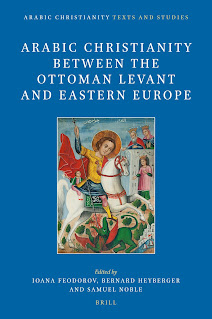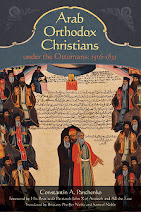Source.
The Politics of church land administration:
The Orthodox Patriarchate of Jerusalem in late Ottoman and Mandatory Palestine, 1875 – 1948
by Konstantinos Papastathis and Ruth Kark
Introduction
The Orthodox Patriarchate of Jerusalem is institutionally structured as a monastic Brotherhood, having as its primary duty the protection of Orthodox rights over the Christian Holy Places. The alleged lack of pastoral interest in the laity, coupled with prevention of the admission of Arab clergy to the religious bureaucracy by the dominant Greek ecclesiastics, led from the nineteenth century onwards to a significant internal polarization between the two groups. The Arab nation-building process, the Greek national myth of Helleno-Orthodoxia, the activity of foreign powers in the Holy Land and especially that of Russia, the overall secularization process after the Tanzimat reforms, and the development of an Arab Christian bourgeoisie have all been analytically described as substantial factors in the formation of the Arab Orthodox movement and the subsequent dichotomy between the Greek Patriarchate and the Arab congregation.
Overall, the local Orthodox viewed Greek rule as the ‘outsider’ that had usurped the Arab cultural patrimony. For that reason they believed that they should acquire full control of Patriarchal affairs or at least participate on equal terms in the administration. Following the paradigm of the other ecclesiastical jurisdictions, and with Russian support, the Arab Orthodox demanded an end to alleged religious imperialism via the laicization of the communal power structures and the establishment of a Mixed Council. On the other hand, the dominance of Helleno-Orthodoxia, i.e. the complete equation between the Greek national identity and Orthodoxy, led the Greek hierarchy to treat any Arab claim as a hostile act that should be opposed by all possible means.
The dispute, however, had an economic aspect as well, i.e. the administration of the immovable property in which the Brotherhood invested from the mid-nineteenth century onwards. As was noted by James Finn, British Consul in Jerusalem (1846-63), the Patriarchate ‘besides maintaining without diminution its ancient property, … has for several years past pursued a scheme of buying up houses, or shops, or waste ground, or even fractions (kirfits [sic] or twenty-fourth parts) of such properties all over the city indiscriminately, till it is believed that more than a quarter of the whole [within the city walls] has come into their hands as free-hold purchase’. Moreover, certain Patriarchal officials acquired landed properties outside the walls, which were further improved through plantation and cultivation. In the early 1920s the Patriarchate had already become the owner or the trustee of vast amounts of real estate, estimated at about 631 properties. According to Tamari, the Patriarchal vakf, together with the Russian land endowments,were more numerous than ‘Muslim, Jewish, and Catholic endowments put together’. Katz and Kark identified 355 of these properties, of which 176 alone covered an estimated 36,779 metric dunams (1 dunam = 1,000 sq. metres). Moreover, of the total area of 900 dunams of the Jerusalem Old City, 317 dunams belonged to the Patriarchate.
This article suggests that at the core of this rivalry stood the mode of management of the vast Church-owned urban and agricultural real estate. Our aim is twofold: a) to present the historical course of the relevant land dispute from the late Ottoman period to the end of the British Mandate; and b) to critically assess its political connotations within the framework of the nation-building process and the power struggle between state powers with conflicting interests. The general themes under investigation are: Church and state with special reference to the governmental policies towards religious property; and Church and community, with special reference to the ecclesiastical land administration and how this affected the relationship between them. Our thesis is that both the Ottomans and the British pursued a pro-Greek policy.
The article is divided into two main parts. First, we elaborate on the question of land acquisition in late Ottoman times, paying special attention to the instruments used by the Patriarchate to accumulate real estate. In the second part, we examine the dispute in relation to land administration, focusing on its political dimension during a period of extreme social unrest. In conclusion, we critically assess the respective Ottoman and British policies. It is argued that their de facto pro-Greek stance was not only the out-come of their domestic political considerations, but was also dictated by their diplomatic priorities. Moreover, it is argued that the institutional framework established in respect to the vakf properties was another factor blocking Arab involvement in their administration. To this end, the legal channels through which the Patriarchate accumulated them are of special importance.
[...]
Read the whole article here.
The Politics of church land administration:
The Orthodox Patriarchate of Jerusalem in late Ottoman and Mandatory Palestine, 1875 – 1948
by Konstantinos Papastathis and Ruth Kark
Introduction
The Orthodox Patriarchate of Jerusalem is institutionally structured as a monastic Brotherhood, having as its primary duty the protection of Orthodox rights over the Christian Holy Places. The alleged lack of pastoral interest in the laity, coupled with prevention of the admission of Arab clergy to the religious bureaucracy by the dominant Greek ecclesiastics, led from the nineteenth century onwards to a significant internal polarization between the two groups. The Arab nation-building process, the Greek national myth of Helleno-Orthodoxia, the activity of foreign powers in the Holy Land and especially that of Russia, the overall secularization process after the Tanzimat reforms, and the development of an Arab Christian bourgeoisie have all been analytically described as substantial factors in the formation of the Arab Orthodox movement and the subsequent dichotomy between the Greek Patriarchate and the Arab congregation.
Overall, the local Orthodox viewed Greek rule as the ‘outsider’ that had usurped the Arab cultural patrimony. For that reason they believed that they should acquire full control of Patriarchal affairs or at least participate on equal terms in the administration. Following the paradigm of the other ecclesiastical jurisdictions, and with Russian support, the Arab Orthodox demanded an end to alleged religious imperialism via the laicization of the communal power structures and the establishment of a Mixed Council. On the other hand, the dominance of Helleno-Orthodoxia, i.e. the complete equation between the Greek national identity and Orthodoxy, led the Greek hierarchy to treat any Arab claim as a hostile act that should be opposed by all possible means.
The dispute, however, had an economic aspect as well, i.e. the administration of the immovable property in which the Brotherhood invested from the mid-nineteenth century onwards. As was noted by James Finn, British Consul in Jerusalem (1846-63), the Patriarchate ‘besides maintaining without diminution its ancient property, … has for several years past pursued a scheme of buying up houses, or shops, or waste ground, or even fractions (kirfits [sic] or twenty-fourth parts) of such properties all over the city indiscriminately, till it is believed that more than a quarter of the whole [within the city walls] has come into their hands as free-hold purchase’. Moreover, certain Patriarchal officials acquired landed properties outside the walls, which were further improved through plantation and cultivation. In the early 1920s the Patriarchate had already become the owner or the trustee of vast amounts of real estate, estimated at about 631 properties. According to Tamari, the Patriarchal vakf, together with the Russian land endowments,were more numerous than ‘Muslim, Jewish, and Catholic endowments put together’. Katz and Kark identified 355 of these properties, of which 176 alone covered an estimated 36,779 metric dunams (1 dunam = 1,000 sq. metres). Moreover, of the total area of 900 dunams of the Jerusalem Old City, 317 dunams belonged to the Patriarchate.
This article suggests that at the core of this rivalry stood the mode of management of the vast Church-owned urban and agricultural real estate. Our aim is twofold: a) to present the historical course of the relevant land dispute from the late Ottoman period to the end of the British Mandate; and b) to critically assess its political connotations within the framework of the nation-building process and the power struggle between state powers with conflicting interests. The general themes under investigation are: Church and state with special reference to the governmental policies towards religious property; and Church and community, with special reference to the ecclesiastical land administration and how this affected the relationship between them. Our thesis is that both the Ottomans and the British pursued a pro-Greek policy.
The article is divided into two main parts. First, we elaborate on the question of land acquisition in late Ottoman times, paying special attention to the instruments used by the Patriarchate to accumulate real estate. In the second part, we examine the dispute in relation to land administration, focusing on its political dimension during a period of extreme social unrest. In conclusion, we critically assess the respective Ottoman and British policies. It is argued that their de facto pro-Greek stance was not only the out-come of their domestic political considerations, but was also dictated by their diplomatic priorities. Moreover, it is argued that the institutional framework established in respect to the vakf properties was another factor blocking Arab involvement in their administration. To this end, the legal channels through which the Patriarchate accumulated them are of special importance.
[...]
Read the whole article here.








No comments:
Post a Comment